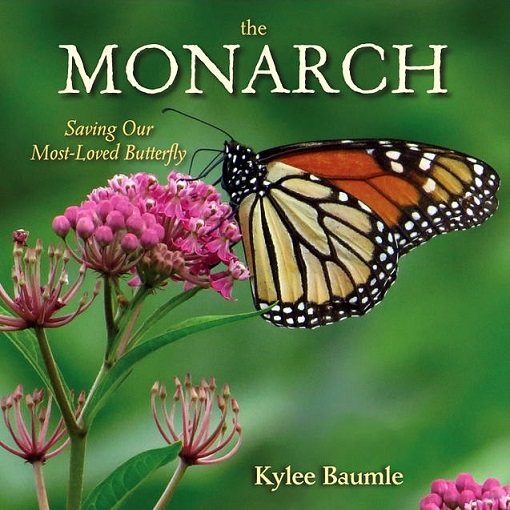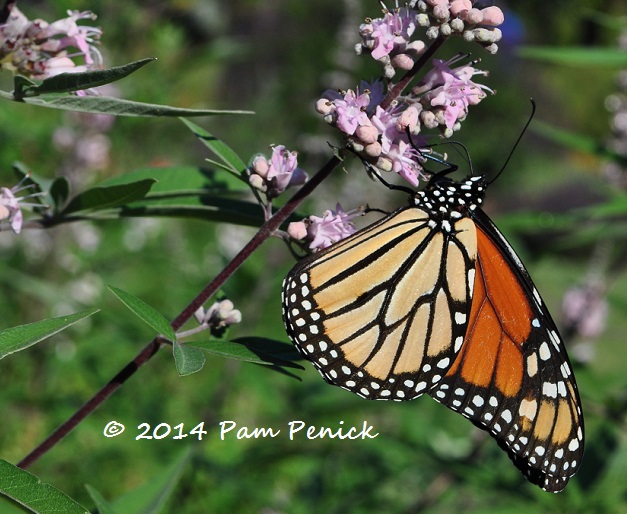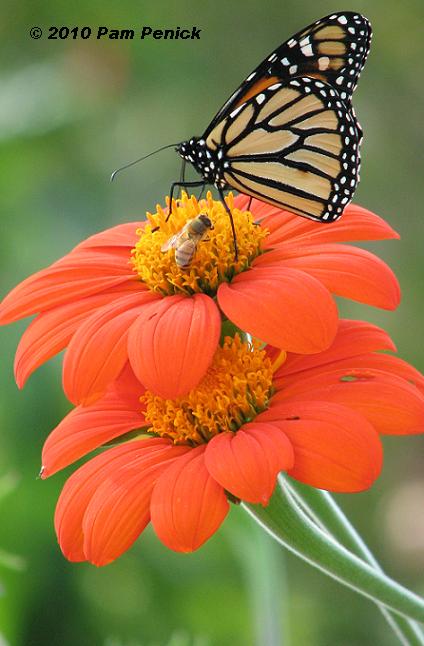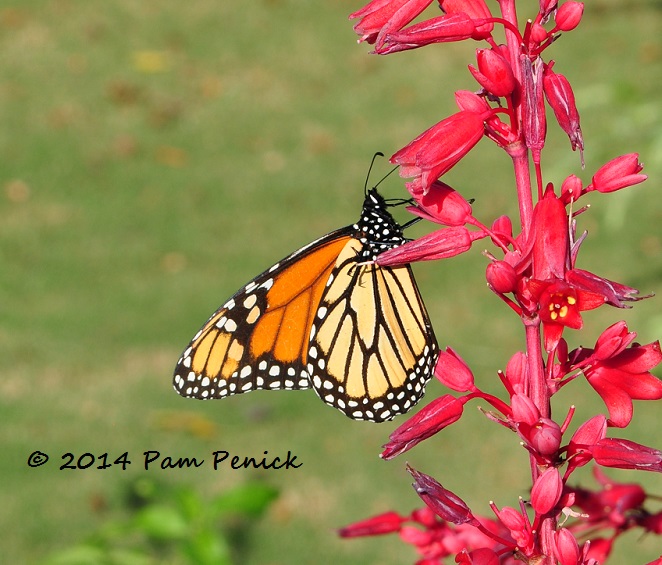Review of The Monarch: Saving Our Most-Loved Butterfly, and how we can help in Texas
The first wave of migrating monarch butterflies has reached North Texas and will be fluttering through Austin and other parts of Central Texas by next week. Despite their seeming fragility, these tenacious creatures migrate each fall as far as 2,800 miles from the northern U.S. and southern Canada to their wintering grounds in central Mexico. It’s a miraculous annual event, and we Texans have front-row seats.
Monarchs are in trouble, though. Due to habitat loss, drought, flood, the use of pesticides and herbicides, and especially the widespread eradication of milkweed, which is the sole food source for monarch caterpillars, monarch populations have plummeted by 90% in the last 20 years. These distinctive butterflies need our help, and each of us can make a difference by creating a healthy habitat for monarchs in our own yards and gardens. Here in Texas that means planting fall-blooming nectar plants for migrating monarchs to fuel up on as they journey to Mexico and milkweed for northbound monarchs to lay their eggs on (and their caterpillars to feed on) in the spring. Plant both nectar plants and milkweed in your garden now.
Awareness of helpful gardening practices is the first step, but there’s plenty more you can do to aid monarchs, as author Kylee Baumle shows in her accessible and well-illustrated book The Monarch: Saving Our Most-Loved Butterfly (St. Lynn’s Press, 2017). Kylee, a longtime blogger at Our Little Acre, raises and tags butterflies as a citizen-scientist, successfully lobbied her state legislature in Ohio to create a monarch-supporting license plate, and has led a tour to the monarch’s wintering grounds in the mountains of central Mexico. In her new book, she shares the inspirational life story of the monarch as well as its current peril, and offers guidance for those wishing to create a butterfly-friendly garden or help in other ways.
The Monarch is an engaging introduction for gardeners and wildlife lovers wanting to know more about our most iconic butterfly. It would also be a good book to share with older children, who will be fascinated by the monarch’s epic journey. And what better way to get kids or grandkids involved in the garden than by inspiring them to help these beautiful creatures?
While you’re reading and watching for a fluttering parade of orange-and-black wings in Central Texas, here are some other ways to celebrate the monarch this month in Austin.
Flight of the Butterflies
What: Movies in the Wild: An outdoor showing of an inspiring documentary about monarch migration
When: Friday, October 6, gates at 6 p.m., movie at dusk
Where: Lady Bird Johnson Wildflower Center, 4801 La Crosse Ave., Austin
Cost: $12/ticket for ages 5 and up; tickets are available Friday at the Wildflower Center, or save time by purchasing in advance online. Members get 50% off (be sure to sign in on the purchase page).
Details: Alamo Drafthouse Cinema and the Wildflower Center are transforming the Family Garden into a theater for one night only. Spread your blanket on the play lawn, and enjoy Flight of the Butterflies, a film about the great journey of migrating monarchs. Bring a picnic and enjoy free brews from North by Northwest Brewery! No outside alcohol permitted. Kettle corn and ice cream available for purchase. Fun activities will include monarch mask-making and a flighty photo-op.
Monarch Appreciation Day
What: An Austin-area butterfly celebration offering fun for the entire family
When: Saturday, October 21, 9 am to 4 pm
Where: Zilker Botanical Garden, 2220 Barton Springs Rd., Austin
Cost: Free with admission to the garden; admission is $1 for children (ages 3-12); $2 for adults, Austin resident (ages 13-61); $3 for adults, non-resident (ages 13-61); $1 for seniors (age 62 & over)
Details: Family-friendly activities including nature crafts, see a monarch eye-to-eye, learn how to attract pollinators year-round, learn how you can be a Pollinator Pal.
Disclosure: St. Lynn’s Press sent me a copy of The Monarch for review. I reviewed it at my own discretion and without any compensation. This post, as with everything at Digging, is my own personal opinion.
I welcome your comments; please scroll to the end of this post to leave one. If you’re reading this in a subscription email, click here to visit Digging and find the comment box at the end of each post.
_______________________
Digging Deeper: News and Upcoming Events
Get ready for fall garden tours in Texas! The Garden Conservancy is sponsoring Open Days tours in Fort Worth on Oct. 8th, San Antonio on Oct. 14th, and Austin on Nov. 4th.
Get on the mailing list for Garden Spark Talks. Inspired by the idea of house concerts, I’m hosting a series of garden talks by talented designers and authors out of my home. Talks are limited-attendance events and generally sell out within just a few days, so join the Garden Spark email list for early notifications. Simply click this link and ask to be added.
All material © 2006-2017 by Pam Penick for Digging. Unauthorized reproduction prohibited.






Thank you, Pam! I’m glad you enjoyed my book and that you wanted to share it with your readers. You know I’m envious of your position in the monarch world. Texans have a front-row seat and are extremely important to monarchs as they make that final push for Mexico and of course, Texas is a “spring”board for each year’s population, as it’s where the migrating monarchs first encounter milkweed as they make their way back north in the spring.
We Texans are indeed in a good position to help the monarchs on their journey by planting what they and their caterpillars need. Thanks for shining a light on this fascinating creature, Kylee, and reminding us that we can all make a difference. —Pam
Thanks for this post. I really appreciate the plant list!
I’m glad you enjoyed it! —Pam
Thanks for the reminder, Pam! I also especially like Power the Migration because of its simplicity and design (5 plants, 2 seasons,3 native milkweeds). https://www.wildflower.org/learn/power-the-migration
And congratulations to Kylee on her book spotlighting monarchs!
Thanks for sharing that helpful webpage, Beverly! —Pam
Thank you, Beverly!
I really enjoy your blogs with the gorgeous photos and helpful info. I have a question about Tropical Milkweed. Some of ours is blooming and I am not sure if we should go ahead and cut it down now.
Bonnie, thanks for that great question! Tropical milkweed is always a topic of controversy, and it’s a very important one in Texas, since it survives for such a long time there. I think it even grows year round in parts of Texas.
The thought is that it prevents monarchs from migrating and that it fosters the spread of OE, a parasite that infects monarchs. OE is a big problem where tropical milkweed grows, and for that reason, it is recommended that it be cut down.
Since monarchs are migrating now, now is a good time to cut it back. I have my own personal beliefs about growing tropical milkweed, but since the experts can’t even agree about whether or not it’s a good idea to grow it, I don’t think I’m in a position to say anything other than it’s always best to grow native milkweeds where possible.
Thanks for your concern about this issue!
I want to add that for those of us in the north, tropical milkweed isn’t so much a problem, as it dies when a killing frost comes along, just like our perennial milkweeds do. It’s only where it has a long growing season and grows year-round where this specific plant seems to cause problems.
Great question, Bonnie. I appreciate that Kylee, author of The Monarch, was able to answer, since I wasn’t sure what to recommend. I’m glad you’re interested in helping the monarchs, and thanks for reading Digging! —Pam
I’ll stop growing any tropical milkweed, when another viable variety becomes available here in nurseries in Houston. Sent off for plants from High Country Gardens. Two croaked. One barely survived and hasn’t ever bloomed. (these were recommended for Texas) So lets talk to the nursery people and wholesalers, shall we?
Sounds like a worthy project! —Pam
They’re doing better, Chris, mainly because customers are coming in and asking for the plants. It will take a while before lots of suppliers get on board with it. When the Perennial Plant Association named butterfly weed (Asclepias tuberosa) the Perennial Plant of the Year for 2017, that speaks to the change we hope will continue.
Milkweeds don’t like being transplanted, so that’s an issue. The best success comes from growing from seed, but it’s important to note that perennial milkweed seeds require cold/moist stratification for best germination. I recommend sowing them in the fall so Mother Nature can do that naturally, although you can simulate it in the refrigerator.
Oh how I love those monarchs, and Kylee’s book! I raise a very small batch of monarch caterpillars in my kitchen, but that’s only because I haven’t had much luck with milkweed in my suburban yard. But I keep trying!
What do you feed them in your kitchen, Robin? —Pam
Thank you, Robin!
I have about 12 native milkweed plants (swamp, butterfly, and green) that I was able to get from a nursery in Cedar Park (Hill Co Water Gardens)…. I saw several monarch cats and got to see 3 emerging monarchs from the chrysalis. It was thrilling!! So glad I planted these and intend to increase the number next year!
How exciting, Lori! I’m still waiting to see a caterpillar on my solitary milkweed, but I figure it may take a monarch mama a little longer to find it. —Pam
You GO, Lori! Keep up the good work!